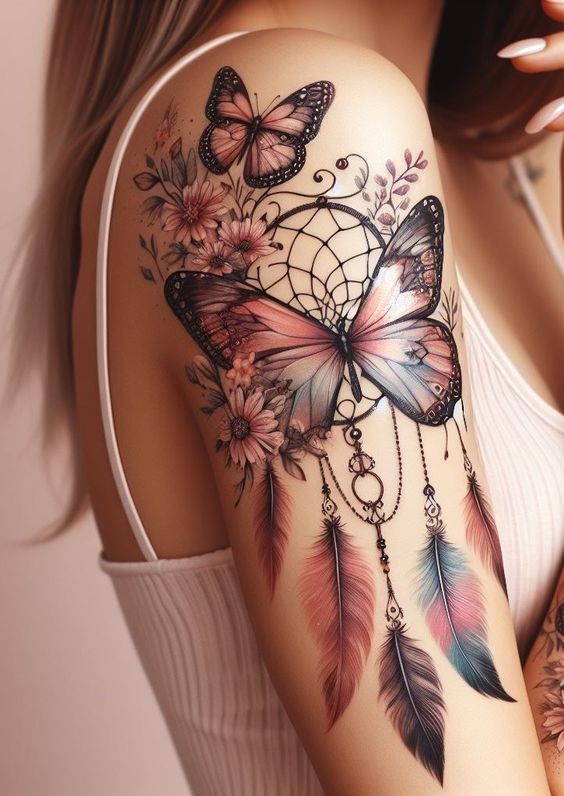The Allure and Significance of Dream Catcher Tattoos
Dream catcher tattoos have become a popular choice for body art enthusiasts, reflecting both aesthetic appeal and deep cultural significance. This article delves into the origins, symbolism, design variations, and cultural appropriations associated with dream catcher tattoos.
Origins and Cultural Significance
Dream catchers have their roots in the Ojibwe (Chippewa) culture, an Indigenous people of North America. Traditionally, dream catchers were handcrafted using natural materials such as willow hoops, sinew, and feathers. They were believed to protect sleeping individuals from bad dreams while allowing good dreams to pass through. The dream catcher’s web-like design was intended to trap bad dreams, which would then be destroyed by the first light of dawn.
In traditional Ojibwe culture, dream catchers were not originally used as tattoos. They were primarily hung above beds or cradles, serving as protective talismans. The symbolism attached to dream catchers—protection, spiritual guidance, and the filtering of negative energies—has transcended its cultural origins and found expression in various art forms, including tattoos.
Symbolism and Meaning
Dream catcher tattoos often symbolize protection, wisdom, and the filtration of negativity. The intricate design of a dream catcher consists of several elements, each imbued with specific meanings:
The Hoop: The circular shape represents the cycle of life, unity, and the never-ending nature of existence. It symbolizes the continuous flow of energy and the interconnectedness of all beings.
The Web: The web within the hoop signifies the filtering process of dreams and experiences. It’s believed to catch bad dreams and let the good ones pass through, representing the discernment between positive and negative influences in life.
The Feathers: Feathers are often attached to the bottom of the dream catcher and represent the breath of life, spiritual guidance, and connection to the divine. They also symbolize the lightness and freedom of good dreams.
Beads: Sometimes, beads are included in the web of the dream catcher tattoo. They can represent spiritual energy or the connection between the physical and spiritual realms.
Design Variations
Dream catcher tattoos come in a variety of styles, reflecting both traditional and contemporary interpretations. Here are some popular design variations:
Traditional Design: This style closely mimics the classic dream catcher, featuring a circular hoop, an intricate web, and feathers. It often adheres to traditional color schemes and patterns, paying homage to its cultural origins.
Minimalist Design: For those who prefer a subtler approach, minimalist dream catcher tattoos simplify the design to basic shapes and lines. This style focuses on the essential elements of the dream catcher while maintaining a modern aesthetic.
Watercolor Design: Watercolor tattoos use vibrant colors and fluid brushstroke effects to create a dream catcher that resembles a painting. This style often blends the dream catcher with other elements like flowers or animals, adding a unique and artistic touch.
Geometric Design: Incorporating geometric shapes and patterns, this style combines the dream catcher with abstract elements. The geometric design can give the tattoo a contemporary and sophisticated look.
Animal Integration: Some dream catcher tattoos incorporate animals, such as wolves, owls, or feathers, into the design. These tattoos blend the symbolism of the dream catcher with the characteristics of the chosen animal, adding layers of meaning.
Cultural Appropriation and Sensitivity
While dream catcher tattoos can be deeply meaningful, it’s important to approach them with cultural sensitivity. Dream catchers are sacred symbols in Indigenous cultures, and their use outside these cultures can sometimes be seen as appropriation. Cultural appropriation involves adopting elements of a culture without permission or respect, often reducing complex cultural symbols to mere fashion statements.
If you’re considering a dream catcher tattoo, it’s crucial to:
Research Thoroughly: Understand the origins and significance of the dream catcher within Indigenous cultures. Acknowledge the cultural context and respect the symbol's heritage.
Consult Indigenous Artists: If possible, work with Indigenous tattoo artists or seek guidance from Indigenous communities. They can provide valuable insights and ensure that the tattoo is done respectfully.
Be Mindful of Representation: Avoid designs that may trivialize or misrepresent the dream catcher’s cultural significance. Opt for tattoos that honor the symbol’s roots rather than exploit them.
Conclusion
Dream catcher tattoos are more than just decorative body art; they embody rich cultural symbolism and personal significance. From their traditional roots in Ojibwe culture to their modern adaptations, dream catcher tattoos offer a way to connect with deeper meanings of protection, wisdom, and spiritual guidance. However, it’s essential to approach the subject with cultural respect and awareness to ensure that these tattoos are worn with the honor and appreciation they deserve.






